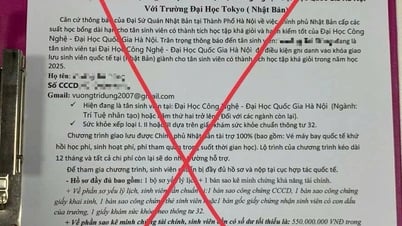Ho Chi Minh City: Private sector workers' pensions are calculated for the entire period of social insurance contributions, while public sector workers' pensions are calculated on average for the last years, so there is a difference, according to a representative of Quang Viet factory workers.
The opinion was expressed by worker Vu Thi Hien, who works at Quang Viet Garment Company in Cu Chi District, at a meeting with voters of the delegation of Unit 10 of the Ho Chi Minh City National Assembly Delegation on the morning of May 5. This was a thematic meeting jointly organized by the City Labor Federation to listen to comments on the draft amendments to the Law on Social Insurance and the Law on Housing.

Worker Vu Thi Hien expressed her opinion at a meeting with National Assembly Delegates. Photo: Le Tuyet
According to the female worker, the current pension calculation differentiates between private sector workers and civil servants. For state employees, depending on the time they started participating in social insurance, their pension will be calculated based on the average of the last 5-10-20 years. Only those who started participating in social insurance from January 1, 2025, after reaching retirement age, will their pension be calculated based on the entire contribution period. Meanwhile, for workers up to now, pensions have been calculated based on the entire participation period without any adjustment roadmap.
Ms. Hien gives an example of two people starting work in 2000 and retiring in 2035. For civil servants, pensions will be calculated on average for the last 6 years. Because salaries increase with seniority, this calculation is beneficial, and pension benefits are also high. Meanwhile, if they are workers, pensions are calculated on average for the entire 35 years. Before 2008, workers' salaries were very low, only a few hundred thousand VND, even with inflation compensation, it was still lower than the average calculation of the last years.
"To be fair, it is necessary to adjust the pension calculation method for private sector workers according to the same roadmap as for state employees," the female worker suggested.

Depending on the time of participation in social insurance, the pension of state officials and civil servants will be calculated based on the last 5-20 years, while private sector workers will be calculated based on the entire participation period. Graphics: Tien Thanh
Previously, answering VnExpress , Mr. Bui Sy Loi, former Deputy Chairman of the National Assembly's Committee on Social Affairs (now the National Assembly's Committee on Social Affairs), also said that there was an unfairness in pension policies between the public and private sectors. For example, in the state sector, according to the roadmap, depending on the time of participation, pensions are calculated on average for the last 5 years and currently 10 years. However, in the sector with labor relations, the whole process is calculated.
"In any case, your pension calculated for the last 10 years will be higher than your pension calculated for the last 30 years. This is unequal, leading to workers being jealous of the state sector," said Mr. Loi. Therefore, in paying pensions, the principle of sharing needs to be taken into account so as not to lead to too large a difference between beneficiary groups.
Current law stipulates that employees who reach retirement age under normal working conditions and have paid for 20 years or more are entitled to a pension. The benefit is equal to 45% of the average monthly salary for social insurance contributions and corresponds to the number of years of contributions. To receive the maximum 75%, employees must pay for 30-35 years. With the excess participation time, employees will receive a one-time subsidy with the payment of half a month's salary per year of contribution.
At the meeting, workers also said that it is necessary to recalculate the payment level for the excess contribution period after receiving the maximum pension.
Chairwoman of the Ho Chi Minh City People's Council Nguyen Thi Le said that she will take into account the opinions of workers when discussing the drafting of the Social Insurance Law at the National Assembly. According to the plan, the consultation for the bill will end in May, and the Drafting Committee will submit it to the Government in June. The bill will be submitted to the National Assembly at the October 2023 session for discussion and comments, and voted for approval at the May 2024 session.
Le Tuyet
Source link



































































































Comment (0)